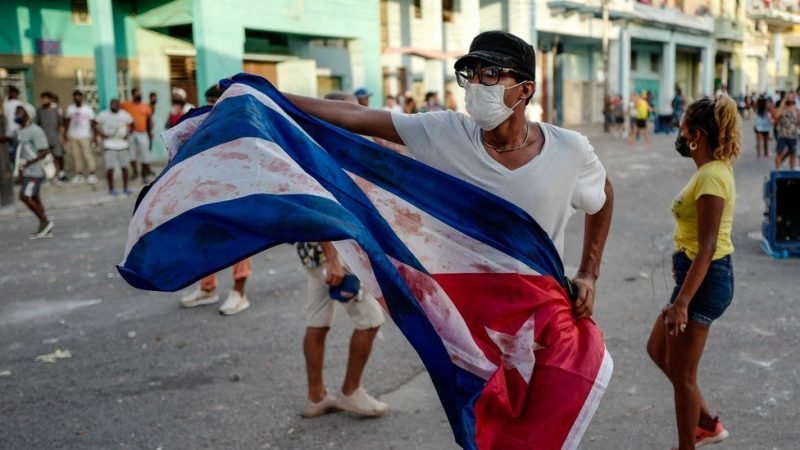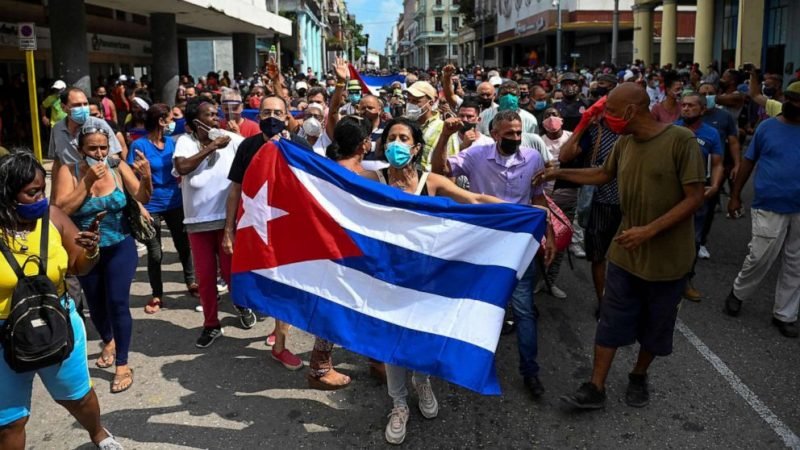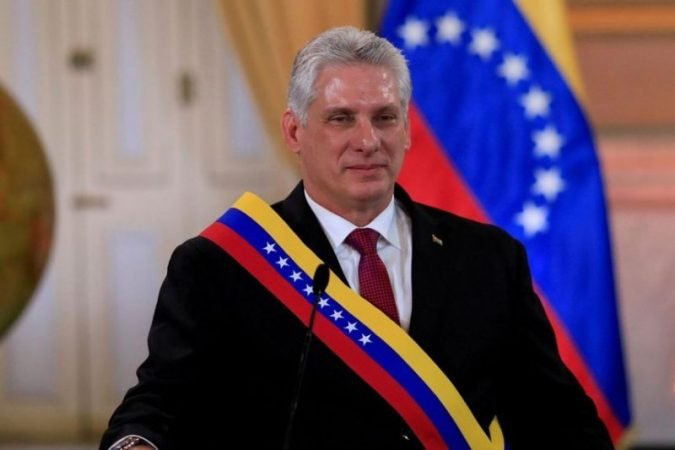Time for Cuba’s shift from Patria o Muerte to Patria y Vida ?

Many politicians have an attitude that in their drive to stay in power, anything goes. Dictatorships have used populism to gain power throughout history, and they frequently do it by appearing to be someone they are not. In recent weeks, there has been an enormous surge of anti-communist rallies in Cuba. Since the Cuban Revolution in 1959, when Marxist-Leninist revolutionaries headed by Fidel Castro took power, open opposition has been unusual in the one-party state. Fidel Castro rose to power on the promise of ending Fulgencio Batista’s despotism in Cuba, only to follow through with an equally heinous totalitarian government that lasted more than half a century. Castro’s power ambitions were not confined to his nation, but he worked to extend Marxism-horrors Leninism’s throughout Latin America.
The deteriorating economic condition in Cuba has made an already poor populace even more desirous of change. As things stand, even basic essentials in Cuba might be difficult to come by. This desperation has led to an unprecedented number of Cubans flocking to the streets to protest against the system, despite the frequent harsh repercussions of doing so. Citizens in Cuba do not have the option of seeking change through political means. Freedom of expression and organization are fictitious and internet access is severely limited.
Money Matters and Money, Matters!
The latest wave of demonstrations is fueled in part by Cuba’s worsening living standards. While Cubans have suffered several economic difficulties in the past, the situation is today particularly grave. Many Cubans appear to have lost patience as a result of food and medical shortages, as well as power outages and a health system trying to cope with the COVID-19 pandemic. The time has come for ordinary Cubans to take action in openly demanding civil freedoms and an end to the communist dictatorship, according to the demonstrators and their allies in the Cuban diaspora. The Cuban dictatorship has oppressed and impoverished the populace for more than six decades, persecuting political opponents and minorities, engaging in severe censorship, disregarding property rights, and generally oppressing and impoverishing the population.

Today, with the help of social media and the capacity to partially circumvent internet restrictions, Cubans who are eager for a better future have been able to organise a grassroots movement while well conscious of the potential implications of their activities. The Cuban dictatorship has sought to depict itself as a socialist success story with outstanding public services and high living standards, which might be a utopia if it weren’t for the imperialist US and its sabotage attempts. The reality in Cuba, however, is far different from what the propaganda portrays.
Although American sanctions have had a detrimental influence on the Cuban economy with little benefit to the oppressed populace, the country’s current economic difficulties are due to consecutive generations of communist rule. Following the Cuban Revolution, Fidel Castro nationalised industries and companies, but unlike other authoritarian nations like China, the Cuban dictatorship remained ideologically rigid in its financial policies. Cuba’s government has continually failed as well as ignored the need to make the reforms that would allow the country to prosper economically. Furthermore, the country has experienced skyrocketing inflation rates in recent months as a result of the government’s decision to weaken the Cuban peso in an effort to promote exports.
Cuban Authorities = Brutal Repressions
Just as it was in the past the Cuban government has taken the same repressive measures this time around too, not much to everyone’s surprise it is the same zero-tolerance policy towards open criticism against the regime. The Cuban dictatorship has arrested and jailed protestors without alerting the families of their location in the weeks after the protest movement began, frequently for many days. Nearly 700 individuals have been detained, according to activists, with many more still missing. Individuals are often detained for activities like photographing and distributing footage of protests, rather than for acts of violence or crimes that would be recognised as such in other nations. A year in prison has been imposed on the photographer who shot portions of the music video for “Patria y Vida.” Journalists and political activists are also being prevented from leaving their houses by government officials. Reporters Without Borders has long regarded Cuba, which is placed 171st in the 2021 World Press Freedom Index, to be Latin America’s worst abuser of press freedom. Journalists who do not conform to the regime’s narrative are subjected to intimidation and punishment by the government.
The Blame Game
A large number of demonstrators blame Cuba’s government for the widespread suffering, according to their anti-government slogans. This feeling appears to be a recurring one throughout Cuban history. The public was also showing scorn for the administration the last time such strong and broad protests erupted in the country. During the Moleconazo in the summer of 1994, throngs of Cubans stormed the streets, screaming “Down with the Castros!” and “Freedom!” Mr Diaz-Canel, the Cuban president, blamed the United States for bringing Cuba to its current situation, maybe in an attempt to transfer blame. Mr Diaz-Canel believes that the United States has recently sought to undermine and disrupt Cuba’s economy in order to “provoke a catastrophic societal collapse.”

The Beginning of the end for Communist Cuba?
Looking at Cuba today it seems like it has more ghost towns than any other tightly controlled communist state. That’s why hundreds of people demonstrated across the nation lately, pleading for food and freedom while experiencing the greatest per-capita COVID-19 outbreaks in Central America. For decades, the government has had near-total control over information flow, which has been critical to keeping control over the downtrodden and impoverished populace. The times, however, are changing. With the current wave of protests, there is a growing fear that communist rule may be coming to an end. People are no longer scared to challenge the system, and the governing party appears increasingly concerned about the future. The rest of the world is watching. An increasingly large worldwide audience is becoming aware of Cuba’s terrible reality and expressing sympathy with the Cuban people in their valiant battle for freedom and prosperity. On July 12, Biden urged Cuba’s leadership to pay attention to the demonstrators and take their concerns seriously. Biden, on the other hand, does not want to appear to be providing a lifeline to Cuba’s Communists at a time when they are facing the largest rallies in decades. He won’t even have to take first moves in the direction of the Cuban dictatorship, such as removing Cuba from the list of state sponsors of terrorism, as long as demonstrations persist. Furthermore, both Florida Democrats and Donald Trump are delighted to remind Biden how simple it is to depict Democrats as dangerous socialists in a state that is still a key battleground for the White House and congressional power. Those who have pushed socialism in other similar states have felt burnt of it and ultimately ended up in the list of failed states which largely just includes the communist bloc.


















